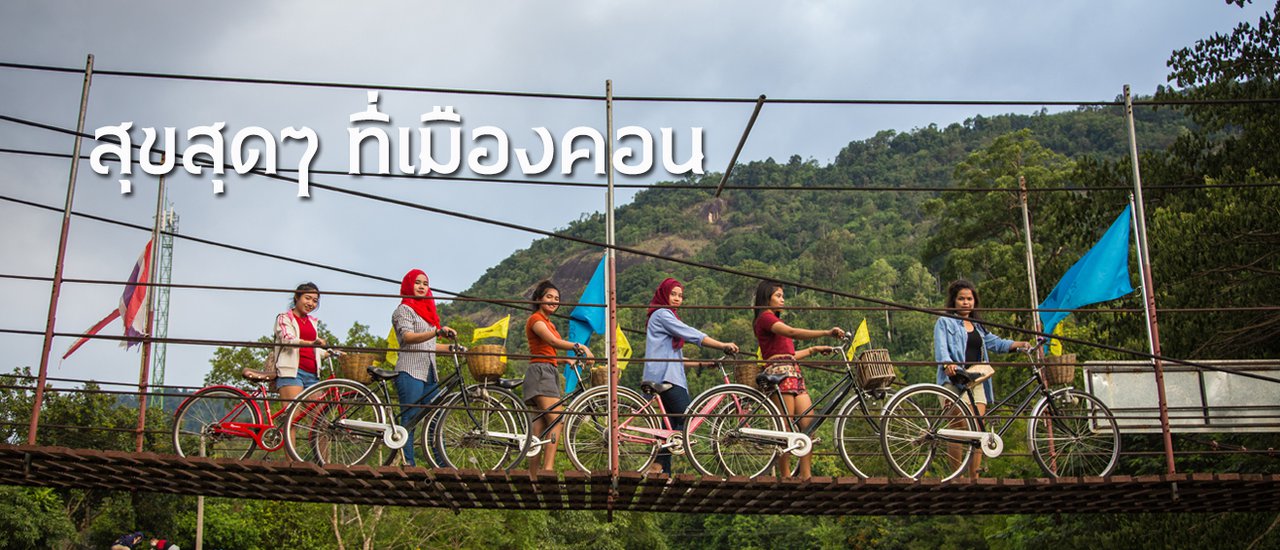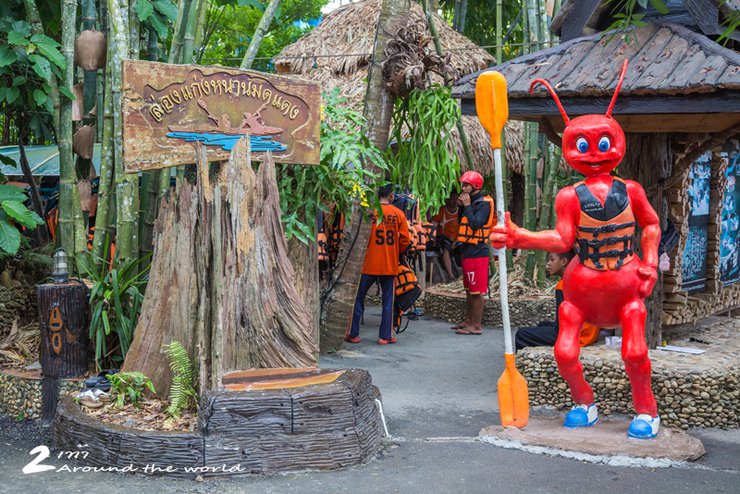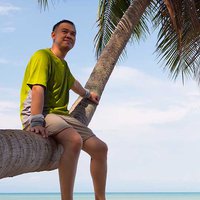
This trip, let's travel across regions, from the Central Region to the South, with Nakhon Si Thammarat as our destination. Let's see where I went during my 3 days and 2 nights trip.
My first destination was Pa Phayom District, Phatthalung Province, bordering Nakhon Si Thammarat Province.

My first activity was white water rafting at Nam Mad Daeng. There are many rafting operators in the area, but I chose to go with Nam Mad Daeng because they are a pioneer in the activity and also offer other activities such as treetop slides. They also have accommodation and a conference center.

Storage locker

Visitors who have not brought their own clothing can purchase items at the Nan Madan Red Ant Market at affordable prices. These items can be worn immediately or given as gifts.

Before embarking on the whitewater rafting adventure, participants will receive a comprehensive briefing on safety procedures and proper rafting techniques. Additionally, a thorough inspection of all equipment, including life jackets and helmets, will be conducted to ensure the safety of all participants. The starting point for the rafting expedition is located at the tail end of the Huai Nam Sai Reservoir, which can be accessed by car from the Nan Mad Daeng campsite.



Whitewater rafting here is relatively safe and can be enjoyed year-round. The Huai Nam Sai Reservoir regulates the water level, eliminating concerns about flash floods during the rainy season. Along the rafting route, there are approximately 40 rapids, with 5 rapids that elicit the most screams from tourists: Uncle Juan Rapid, Two Brothers Rapid, Red Ant Rapid, Long Rapid, and Bamboo Rapid. The total distance is approximately 6 kilometers, and the rafting time is about 2 hours.
The lush greenery lining both sides of the path offered a glimpse into the area's rich natural beauty. The water was so clear in some sections that fish and algae could be seen. Visitors have the option to paddle their own kayaks or have staff members do so for them. I opted to paddle myself, which was enjoyable at first, but as I continued, I found myself veering off course, frequently drifting left and right. This quickly depleted my arm strength. Initially, I managed to stay with the group, but I eventually fell behind. Fortunately, another member's boat, which had a staff member paddling and was responsible for bringing up the rear, was nearby. I ended up clinging to their boat, as otherwise, it would have likely taken me 3-4 hours to return to the starting point at Nam Mad Daeng.

After a long day, we decided to relax with a herbal steam bath. The spa offers complimentary herbal steam rooms for guests to enjoy.

The changing rooms and shower facilities are plentiful. For the cost of only 200 baht, I believe this whitewater rafting experience is an incredible value. It provides an opportunity to experience nature up close and provides over 2 hours of exhilarating fun.
After the whitewater rafting activity, I headed to Pak Phanang District to find and taste the best of Nakhon Si Thammarat, the Siam Ruby pomelo from Baan Saeng Wiman.



The Siamese ruby pomelo, a specialty of Pak Phanang, is a variety derived from the Khao Phuang pomelo, known for its reddish-pink flesh and sweet flavor. Through years of local cultivation and selective breeding, the Siamese ruby pomelo was developed, boasting a deep red, ruby-like flesh and a sweet, fragrant, and tender taste. Don't miss the opportunity to try this unique fruit! You can find it along the Pak Phanang-Nakhon Si Thammarat road, near Baan Saeng Wiman. Prices range from 150 to 400 baht per fruit, depending on size.
For the first night, I stayed at The Peak Boutique Hotel.

The Peak Boutique Hotel enjoys a convenient location, situated within close proximity to the city center and Robinson Department Store. The hotel boasts ample parking facilities.


The open-plan lobby creates a spacious and inviting atmosphere.

There is also a swimming pool.
The original text is empty. Please provide the text you want me to translate.

The area opposite the Lobby is a guest lounge.



The room is decorated in a raw style, with exposed concrete walls. Although the room is not spacious, it does not feel cramped. There is a small balcony where you can go out and get some fresh air. The amenities are standard for a hotel. I think the room rate is good value for money. It is another option for those who like accommodation in the hundreds, but with everything you need, plus breakfast.
Although my accommodation includes breakfast, I'd like to try something special this morning. I'm going to have dim sum at Tang Kia But Teeyam, a restaurant recommended by my friend in Nakhon Si Thammarat. It's a must-try, as Tang Kia But Teeyam is considered one of the best and most famous restaurants in the city.




Tang Kee Dim Sum Restaurant, located in Muang Thong Village, boasts a lively atmosphere with a bustling clientele. Be prepared for a short wait due to its popularity. The extensive dim sum menu offers a wide variety of options, while the bak kut teh is also a must-try. Overall, the flavors are satisfactory.
For the second day, I have a program to breathe in the ozone at Ban Kiriwong, in the Lan Saka district.

Nestled amidst the embrace of majestic mountains, the quaint village of Ban Kiriwong is nourished by the lifeblood of Khlong Tha Dee canal. This idyllic community boasts the title of Thailand's region with the most pristine air quality.


This bridge serves as the welcoming hall of Khiriwong. Visitors to Khiriwong would undoubtedly stop to take pictures with this bridge. During my visit, a rainbow appeared to greet me.

For those who enjoy the outdoors, lush forests, pristine streams, and a slow-paced travel experience, this destination ticks all the boxes.


Another highlight of Khao Kiri Wong is undoubtedly this suspension bridge.



Exhausted from our travels, we decided to take a break and enjoy some refreshing drinks at Krua Lam Nga, located near the suspension bridge. Krua Lam Nga is the restaurant of Khiriwong Riverside View. The ambiance is truly remarkable, offering stunning panoramic views of Khlong Tha Dee from the dining area.
A Tropical Feast: A Bountiful Harvest of Mangosteen, Durian, and More
If you happen to visit during the right season, you'll be treated to a feast of fresh, local fruits. Imagine savoring juicy, plump mangosteens, alongside a variety of durians, from the classic "durianบ้าน" to the prized "หมอนทอง" variety. And let's not forget the rambutans and the freshly picked, crisp star apples.
The sight of the durians was simply irresistible, and I couldn't resist indulging in almost a whole one myself. I even brought back some durian paste as a souvenir for my family.
In addition to bringing back durian paste as a gift for my family, I also brought back naturally dyed fabric products as gifts for my colleagues. The tie-dye fabrics at Ban Kiriwong use tree bark, leaves, mangosteen, and sataw as dyes. The naturally dyed fabrics are then designed to transform ordinary fabrics into value-added products. The products I saw included shirts, pants, pencil cases, phone cases, cloth bags, and backpacks. There was such a wide variety that I was spoilt for choice. I ended up buying several items.
From Lanska district, I headed to Khanom district, which is located north of Mueang Kon. It took almost 2 hours to get there. My first destination was Jasmine Resort, where I would be staying for the night.

Jasmine Resort opened in mid-2015. The resort is not located directly on the beach, but is approximately 350 meters from Khanom Beach.

If you park your car in front of the resort, walk up the stairs to the restaurant. You can then walk through the restaurant to the lobby.

Alternatively, if you park inside the resort, you can walk along the side of the restaurant to reach the lobby. Please note that you cannot access the accommodation area directly from the parking lot. To enter the accommodation area, you must walk through the front of the lobby and use your access card to open the door.

The Lobby is located in this room, which I call the multi-purpose zone because it serves as the Lobby, dining room, and coffee corner. Upon check-in, the resort will request a 500 baht security deposit for the access card to the accommodation zone.

Upon entering the accommodation zone, the swimming pool is the first eye-catching feature. In the first section of the guest rooms, there are 10 rooms, including 6 Superior pool rooms. Guests can open their room doors and walk directly into the swimming pool.


During my stay, all 6 rooms were fully booked. However, when I arrived, there was 1 room that the guest had not yet checked into. I asked the resort for permission to take photos of the room's atmosphere to share with you. The interior space is quite spacious, with a sofa and a small dining table area provided. The rooms here are tiled. As I mentioned, if you open the sliding door, you can walk directly into the swimming pool.

The bathroom is also spacious. The price of this room is 2,500 baht.
The remaining four rooms in this first accommodation zone are Standard rooms. Two of these rooms are adjacent to the swimming pool, while the other two, located on the left and right wings, are not. I stayed in the room by the edge.

Although the left and right wing rooms do not have direct access to the swimming pool, it is not a major inconvenience as the pool is just a few steps away from the rooms.



The room size is slightly smaller than the first type, but it doesn't feel cramped at all. This is probably because almost half of the room is made of glass, making the room feel airy, spacious, and comfortable.

The room was well-equipped with amenities that met the standards of a typical hotel. What I particularly liked was the abundance of electrical outlets in the room, perhaps even more than necessary.

The bathroom is also spacious, with a wet and dry area separated by a curtain. The price per room is 2,000 baht.
The second area requires a short uphill walk, which my family was able to manage, and I slept in this zone.


This room is a sea view room that can accommodate 3 people. This zone is located on a hill with a spacious living area. If you want to swim, you can walk to the pool below. The rooms in this zone offer stunning views of the Khanom Sea.

The bathroom in the Jasmine room is remarkably spacious. The room rate is 2,500 baht.


A short walk up the hill leads to two more rooms at the very top, both with sea views. The special feature of these rooms is that they have a private swimming pool, shared only by the two rooms. While swimming, you can also enjoy a panoramic view of Khanom Bay in the distance. Each room can accommodate up to 5 people, making it ideal for families or groups of friends. As both rooms were occupied during my visit, I was unable to capture the interior ambiance. Please note that the Sea View rooms are located on a hilltop, requiring a climb up some rather steep stairs, which may not be suitable for elderly guests.
After a relaxing break, it's time to refuel for dinner. Tonight, I'm following the reviews of many people to visit Krua Tangke.



The atmosphere is excellent, with a riverside location.

The must-try dish is the Mieng Pla Samli, which I would rank as my personal favorite. It costs 350 baht per serving.

Spicy stir-fried mackerel, perfectly balanced with a kick of heat. This dish is a true delight for the senses, priced at 280 baht.

Sweet and sour tamarind prawns, a perfect balance of tangy and sweet, to cool down the spiciness of the stir-fried mackerel with turmeric. This dish costs 350 baht.

The three-flavored grouper has a well-balanced flavor. The fish is of a decent size and the flesh is perfectly fried. This dish costs 450 baht.

A must-try dish in the south is stir-fried bai lieng with egg, priced at 100 baht.
The overall taste of the food is delicious. However, the price may be a bit high. But if you compare it to the quality and taste, it is acceptable.

The Tangke Kitchen is a restaurant located in the Anavilla, which is considered another interesting place to stay.


After dinner, I headed straight back to my accommodation. I need to get some rest tonight, as I have an appointment with the pink dolphins tomorrow.
For breakfast, the resort offers a set menu with a choice of ABF or rice porridge. All menus include bread, coffee, and orange juice. Breakfast is served from 8:30 AM to 10:30 AM.

This morning, I had a scheduled boat trip to see dolphins at 8:30 AM. If I waited for the restaurant to open, I would not be able to make it on time. Therefore, I requested the resort to prepare breakfast for my group beforehand. The resort was very accommodating and asked if I would like to have breakfast at the resort or have it packed in a box. For convenience, I requested to have breakfast at the resort before leaving. However, the resort requested to serve breakfast at 8:00 AM. I tried to negotiate that if I had breakfast at 8:00 AM, I might not be able to make it on time for my appointment. The staff then coordinated with the chef, who was able to serve me breakfast at 7:30 AM. However, I had coordinated this in advance after I checked in. Overall, I was satisfied with the Jasmine Resort. The accommodation was new, clean, and the staff provided excellent service.
After breakfast, I had a plan to go on a dolphin-watching cruise. Most tourists board the boat at Laem Prathap, but I chose to board at Ao Thalay Pier. Curious why I chose to board at Ao Thalay? Follow me, and you'll see why you should board at Ao Thalay.



The Ao Thalad Pier serves not only as a port but also as a picturesque location for photography. The Ao Thalad community collaborated and raised funds to construct this wooden bridge, which they named the Samret Bridge.



Less than five minutes after leaving Ao Thalay by boat, I saw a multitude of tourist boats anchored nearby. I immediately guessed that this was a dolphin-watching spot. Soon after, I saw the dorsal fins of dolphins emerge three or four times before disappearing. I was slightly disappointed. The dolphins I saw were black. In fact, pink dolphins are very old, around 40-50 years old. As they age, their skin color gradually fades.
There are up to 50 dolphins in Khanom. If you want to see them, it is recommended to come early in the morning. The earlier, the better, because if the weather is hot, the dolphins will not come up. Even at 8:30 am, it is considered late.
The group then continued their journey by boat to Koh Nuinok, another significant island located near Ao Thalane.

On the island of Koh Nueay, there is a remarkable wonder: a freshwater well in the middle of the sea.

The freshwater well resembles a footprint, visible only during low tide. During high tide, the well is submerged by seawater. Legend has it that this well is associated with the tale of "Luang Pu Thuat Stepping on the Seawater." It is said that Luang Pu Thuat was traveling by junk from Songkhla to Ayutthaya to study Dharma. In the middle of the sea, a violent storm erupted, making it impossible for the ship to continue sailing. They lowered the sails and anchored for three days and nights until the storm subsided. However, the situation on board became dire as their freshwater supply ran out. The ship's owner, blaming Luang Pu Thuat for the misfortune, ordered him to board a small boat and be left to his fate. As Luang Pu Thuat sat in the small boat, he dipped his foot into the seawater and instructed the sailor to scoop up the water and drink it. Miraculously, the water was fresh. This event earned him the respect and reverence of the people on board. However, from a scientific perspective, geologists explain that this freshwater well is an opening connected to a crack in the rock layer below the surface. This crack connects to an underground water source that seeps down from the mainland. When the sea level drops, the freshwater below pushes out the saltwater, creating a freshwater well in the middle of the sea.


The summit of Koh Nuea Nok is home to a revered statue of Luang Pu Thuat. If you have the opportunity to visit Koh Nuea Nok, be sure to ascend to pay respects to the statue of Luang Pu Thuat for auspiciousness.

The journey continued to the next destination. Along the way, a glimpse of a dolphin greeted us, but it was still the same black dolphin as before. In addition, we witnessed another wonder of nature: an island with a geological feature that resembled folded fabric.

Fortunately, I took a small boat today, which allowed me to stop by the attractions along the way. Khun Tippy took me to visit this point. On the left is Khao Hin Phap Pha, or Pancake Rock, and on the right is the Pum Puang Stage.


Folded rocks are a geological phenomenon characterized by layers of rock that appear to be folded. They are formed by the sedimentation of different materials in the seabed, which over time become layers of rock. When the Earth's crust changes, erosion occurs, creating layers of rock that are arranged in a way that resembles folded fabric, hence the name "folded rocks." Folded rocks are not always horizontal; in some places, the layers of rock are tilted according to the angle of their formation.


Each layer of rock is incredibly thick. To put it into perspective, imagine me standing or sitting next to one of these layers. Despite my considerable size, I would appear dwarfed by the sheer immensity of the rock formations.

This area is a wide, flat rock platform that resembles a stage, hence its name "Pum Puang Stage." If you wish to visit these two locations, please inform the boat operator in advance so they can prepare a smaller boat for you. This is because smaller boats can access the small beach where the platform is located.

Then we continued our journey by enjoying the scenery on a boat.

This area is called "Khlong Rulet", which is the border area of Khanom District, Nakhon Si Thammarat Province and Donsak District, Surat Thani Province. The angle that I took a picture of is the area of Donsak District.


As the boat passed through the Rulet Channel, the sea was remarkably calm, making it a popular shelter for small vessels. Around the island, small huts can be seen built on the cliffs, which serve as residences for fishermen.

Ms. Tippy led my group on a boat trip to see the seagrass conservation area. In this area, small bamboo poles are planted at regular intervals, each connected by a rope and surrounded by scraps of cloth. This is a way of ordaining the seagrass. Unfortunately, the water was cloudy today, so we couldn't see the seagrass. This area is a magnet for dolphins and dugongs, which come to feed near Ao Thalay.

The area marked by red flags is a marine protected area, also known as a fish sanctuary. This area serves as a breeding ground for fish and other marine life, allowing them to lay their eggs and grow in a safe environment. Fishing is prohibited within the sanctuary, ensuring the survival and growth of the fish population. As the fish mature, they migrate outside the protected zone, where they can be sustainably harvested by local fishermen. This approach contributes to the long-term health and abundance of marine resources, providing a sustainable source of food for the community.
The two-hour boat trip flew by. While we didn't spot any pink dolphins, the sighting of black dolphins and the opportunity to pose for cool photos on the folded rock formations left everyone in the group with smiles. It was definitely a worthwhile experience.
Ao Thalay is a bay with relatively calm waves and abundant natural resources, including seagrass and small fish such as catfish and sea catfish, which are the favorite food of dolphins. All of these factors contribute to the frequent sightings of dolphins in Ao Thalay. Additionally, a unique aspect of dolphin watching in Ao Thalay is the opportunity for tourists to closely observe the seagrass conservation area.
Local resident Ms. Tippy shared that the Ao Thalane pier area is believed to be inhabited by numerous water spirits. During twilight hours, she claims, the area is illuminated by an ethereal glow. While I have yet to personally witness this phenomenon, I plan to investigate further and report my findings. For those curious to experience the presence of these spirits firsthand, overnight accommodations are available at Ao Thalane's welcoming homestays.
After crossing the Saphan Samret Bridge, Khun Thippha took me to pay respects to the statue of Luang Pu Daeng Tisso in the Tisso Kuha Thewa Tham Cave, which is located near the bridge.
This cave has been developed with the cooperation of the Ao Thalay people, who have helped to build a walkway up to the cave. The interior of the cave has also been tiled, making it look clean.




The cave wall features a large opening. Ms. Tippy mentioned that during the afternoon, a beam of light shines into the cave. Next to the large opening, there are small stalactites and stalagmites, some of which resemble tiny saw blades. Initially, I thought this was a dead cave due to the dry appearance of the formations. However, some of the rocks are still active, as water droplets continue to fall.
To reach Ao Telad Bay, if you are unfamiliar with the route, it is recommended to use GPS coordinates to navigate to Wat Tharn Thong. The Ao Telad pier is located just beyond Wat Tharn Thong. Simply drive straight until you reach the end of the road. The pier will be on your left-hand side. The pier may be difficult to spot as it is a relatively new facility and there are usually no boats waiting for tourists. Therefore, it is essential to contact and book a boat in advance before arriving. You can contact Ms. Tip (098-4683842 and 061-6576284) for boat arrangements. The boat rental fee is 1,000 baht and can accommodate up to 7 people. Ms. Tip is a coordinator for the Ao Telad Bay Conservation Tourism Group. You can inquire about tourist attractions, pink dolphin boat tours, and homestay accommodations directly from Ms. Tip.
Near Ao Thalay, there is another tourist attraction, which is Uncle Winyu-Auntie Phong's Fish Spa.

The narrow road leading to the fish spa is lined with towering palm trees, casting a cool and refreshing shade.


A small stream flows through Uncle Winyu and Aunt Phong's garden. This stream is the highlight of the property, creating a wonderfully serene atmosphere. Kayak rentals are available for 100 baht per hour.

The moment I dipped my feet into the water, fish swarmed around and nibbled at them.


The park features pavilions where visitors can relax, enjoy picnics with their own food, or purchase refreshments from vendors within the park.

If you walk into the palm garden, there is a spillway at the very end.

Visitors to the garden are requested to pay a maintenance fee of 20 baht per person. Camping is also permitted at the garden for a fee of 300 baht per tent (accommodating up to 8 people). Please note that bedding is not provided. Visitors are welcome to bring their own tents. For inquiries, please contact 089-7251836.
Not far from Uncle Winyu and Aunt Phong's garden lies the ancient coral pagoda, a historical landmark of Khanom town.



The coral pagoda is located on the top of Thatu Mountain in Chanthathu Tharam Temple. It is believed that the pagoda is about 600-700 years old. It was built by arranging coral stones into a pagoda shape. However, the pagoda that we see today has been renovated, but it still retains its original structure. At the bottom of the pagoda, there are still some traces of coral stones. The top of the pagoda seems to have been completely rebuilt. From the location of the coral pagoda, you can also enjoy the view of Ao Thong Nian.
It's time to say goodbye to the city of Kon. I hope to see you again next time. There are many places I would like to come back to see what I haven't seen yet, such as the pink dolphins, the jellyfish at Ao Thalay, and staying at the Ao Thalay homestay.
Southern Thailand offers more than just stunning beaches. Its lush forests are home to a variety of captivating natural attractions. During my recent trip to Nakhon Si Thammarat, I explored several of these hidden gems, including Krung Ching Waterfall, Tai Rom Yen National Park, Khao Pu-Khao Ya National Park, and Namtok Si Khit National Park. Time constraints prevented me from visiting every location on my list, but each destination I experienced was truly unforgettable. My journey through Nakhon Si Thammarat was an embodiment of pure joy and wonder.
Finally, you can support and follow my work at https://www.facebook.com/unclegreenshirt.
ลุงเสื้อเขียว
Wednesday, October 9, 2024 5:57 PM




















